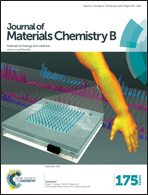Gradient band gap engineered alloyed quaternary/ternary CdZnSeS/ZnSeS quantum dots: an ultrasensitive fluorescence reporter in a conjugated molecular beacon system for the biosensing of influenza virus RNA†
Abstract
Controlling and engineering the particle composition of semiconductor alloys is one of the topmost targets in the field of semiconductor materials science and technology. Quantum dot (QD) nanocrystals offer an unmatched opportunity to obtain a wide range of composition-controlled alloys and have captivated a great deal of interest recently. Herein, we report on band gap engineering via tuning and controlling the sulphur molar fraction (ternary shell layer) of quaternary/ternary core/shell alloyed CdZnSeS/ZnSeS QDs. Varying optical properties were exhibited by the alloyed QDs but a uniform particle size distribution was maintained across all the compositions. The alloyed QDs displayed bright emission colours under UV irradiation, whereas the photoluminescence quantum yields (PL QY) were in a remarkable range of 36–98%. Non-linearity of the lattice parameter was an indication of gradient alloying of the nanocrystals, whereas the kinetics of the optical properties unravelled the effect of intrinsic optical bowing. Displacement of bond length and anion mismatch influenced the optical properties of the QDs with respect to the variation in the PL QY. Alloyed CdZnSeS/ZnSe1.0S1.3 QDs with a spectacular PL QY were exploited as an ultrasensitive fluorescence reporter in a conjugated molecular beacon (MB) assay to detect influenza virus H1N1 RNA. Our detection system was rapid and highly sensitive for detecting extremely low concentrations of H1N1 RNA (down to 2 copies per mL), specific and versatile (detects H1N1 RNA in human serum). For proof of concept, the alloyed CdZnSeS/ZnSe1.0S1.3 QD-MB bioprobe exhibited a superior 12-fold sensitivity over an alloyed CdZnSeS-MB probe, while a conventional CdSe/ZnS-MB probe could not detect extremely low concentrations of influenza virus H1N1 RNA.


 Please wait while we load your content...
Please wait while we load your content...